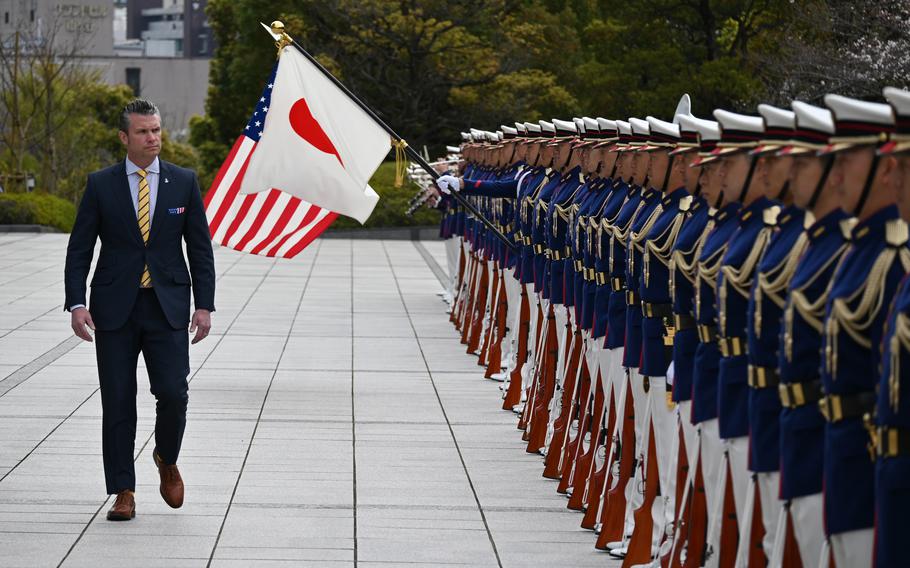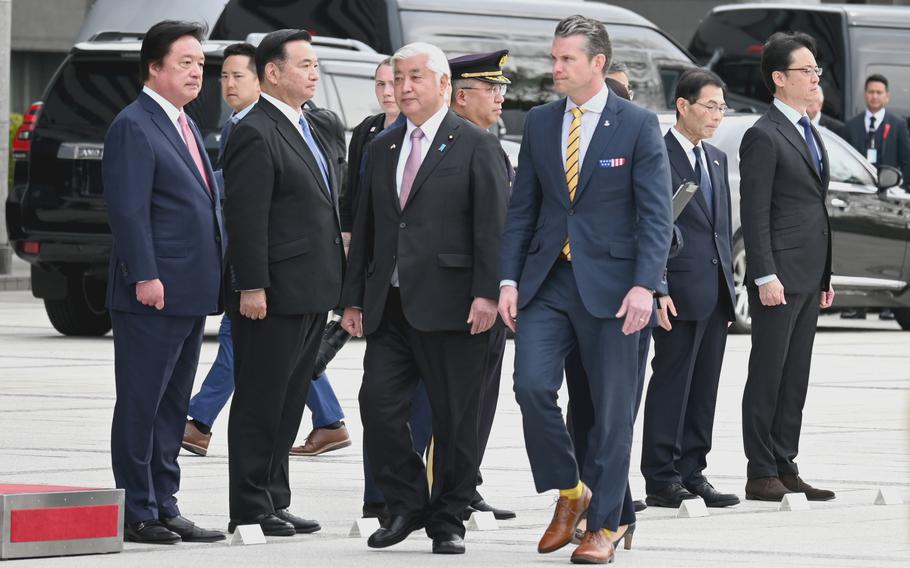
Defense Secretary Pete Hegseth reviews an honor guard at Camp Ichigaya, the Japanese Ministry of Defense headquarters in Tokyo, on March 30, 2025. (Seth Robson/Stars and Stripes)
TOKYO — U.S. Forces Japan has begun reorganizing into a “warfighting headquarters,” U.S. Defense Secretary Pete Hegseth said Sunday during his first trip to the Indo-Pacific since taking office.
Hegseth that day discussed restructuring USFJ amid regional security challenges with Japanese Minister of Defense Gen Nakatani at Camp Ichigaya, the Ministry of Defense headquarters in central Tokyo.
The Defense Department has begun the first phase of upgrading USFJ into a joint force command better equipped to coordinate with its Japanese counterpart, Hegseth told reporters after the meeting.
“This also means reorganizing U.S. Forces Japan into a warfighting headquarters, increasing its staff and giving its commander the authorities needed to accomplish new missions,” he said
USFJ will soon add personnel in central Tokyo and at its headquarters at Yokota Air Base in the western suburbs, Hegseth said.
The upgrade will improve coordination with Japan’s own, recently created, joint operations command, he said.
The Pentagon announced plans in July to modernize USFJ into a command with “expanded missions and operational responsibilities” to complement the Japan Self-Defense Forces Joint Operations Command.
The Japanese command was established in March to take operational control of all three of its armed forces and work closely with USFJ.
Hegseth gave no timeline for the USFJ reorganization but welcomed the creation of the new Japanese command.
“It’s more urgency, it’s more cooperation in real time,” he said. “It also increases our readiness to respond to contingency or crisis, support U.S. operations and help Japan and U.S. forces defend its territory.”

U.S. Defense Secretary Pete Hegseth and Japanese Minister of Defense Gen Nakatani walk past officials of the Japan Ministry of Defense ahead of their meeting in Tokyo on March 30, 2025. (Seth Robson/Stars and Stripes)
CNN earlier this month reported the Pentagon had proposed consolidating four global commands and cancelling the USFJ restructuring to save $330 million over five years. The Republican chairs of the House and Senate Armed Service committees immediately questioned the path forward for that move.
The security environment in the Western Pacific has deteriorated in recent years.
China is rapidly expanding its military capabilities and has vowed to take control of Taiwan — by force, if necessary. Beijing also claims Tokyo-administered islands in the East China Sea.
Meanwhile, North Korea has deployed troops to assist Russia in Ukraine and continues to advance its nuclear and missile technology.
America and Japan stand together in the face of “aggressive and coercive” actions by the communist Chinese, Hegseth said.
“America is committed to sustaining robust, ready and credible deterrence in the Indo-Pacific including across the Taiwan Strait,” he said, noting Japan would be on the front lines of any conflict the allies might face in the Western Pacific.
The U.S.-Japan alliance is the cornerstone of peace and security in the region, Hegseth said. Their goal is increased deterrence, peace through strength and keeping the enemy guessing, he said.
“This means ensuring that we have the right posture in Japan and the right capabilities forward deployed here, whether permanent or temporary,” he said. “It also means expanding access to key terrain in the first island chain such as Japan’s southwest islands and, certainly, it means exercising together at those critical locations.”
The U.S. military is more focused than ever on deterring a Chinese seizure of Taiwan, according to internal guidance reported Sunday by The Washington Post.
An Interim National Defense Strategic Guidance memo, signed by Hegseth and marked “secret/no foreign national” in most passages, was sent throughout the DOD earlier this month, according to the newspaper.
China was identified as the U.S. military’s pacing threat by both the first Trump administration and the administration of former President Joe Biden.

U.S. Secretary of Defense Pete Hegseth met with his Japanese cournterpart, Defense Minister Gen Nakatani, in Tokyo on March 30, 2025. (Seth Robson/Stars and Stripes)
However, Hegseth’s guidance, which the Post said drew from the conservative Heritage Foundation’s Project 2025, describes the potential invasion of Taiwan as a priority over other potential dangers, The Washington Post reported.
“China is the Department’s sole pacing threat, and denial of a Chinese fait accompli seizure of Taiwan — while simultaneously defending the U.S. homeland is the Department’s sole pacing scenario,” Hegseth wrote, according to the newspaper.
Hegseth and Nakatani on Saturday visited Iwo Jima, now known as Iwo To, for a ceremony commemorating the 80th anniversary of a fierce World War II battle between Japan and the United States.
“You and I are both former infantrymen,” Nakatani said, ahead of Sunday’s meeting. “I have experience as a ranger and platoon leader and you, Secretary Hegseth, have experience in the war against terrorism after 9/11 in Iraq and Afghanistan.”
Hegseth thanked the Japanese people for outstanding support of over 100,000 U.S. service members, their families and DOD civilians.
“Our forces from every service train and operate with Japan’s Self-Defense Forces every single day,” he said. “We are inheritors of the same warrior ethos.”